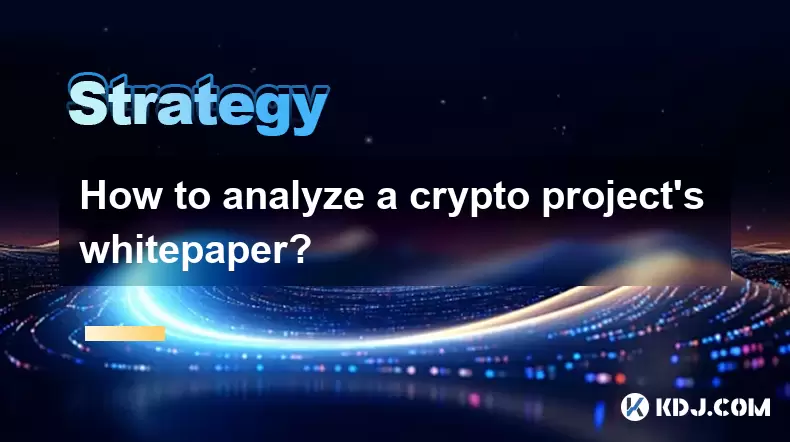-
 bitcoin
bitcoin $122288.232522 USD
0.16% -
 ethereum
ethereum $4480.662914 USD
-0.22% -
 xrp
xrp $2.962747 USD
-2.32% -
 tether
tether $1.000120 USD
-0.05% -
 bnb
bnb $1145.654223 USD
-2.07% -
 solana
solana $227.105217 USD
-1.67% -
 usd-coin
usd-coin $0.999548 USD
-0.02% -
 dogecoin
dogecoin $0.250875 USD
-2.04% -
 tron
tron $0.340654 USD
-0.49% -
 cardano
cardano $0.837968 USD
-2.52% -
 hyperliquid
hyperliquid $48.960449 USD
0.06% -
 chainlink
chainlink $22.049280 USD
-1.33% -
 ethena-usde
ethena-usde $1.000404 USD
0.02% -
 sui
sui $3.586212 USD
0.20% -
 avalanche
avalanche $29.894916 USD
-4.18%
How to analyze a crypto project's whitepaper?
A well-structured whitepaper clearly defines the problem, proposes a feasible solution, and provides transparent details on technology, tokenomics, team, and regulatory compliance to build trust and credibility.
Jul 11, 2025 at 01:57 pm

Understanding the Purpose of a Whitepaper
A whitepaper serves as the foundational document for any cryptocurrency project, outlining its core concept, technical details, use cases, and roadmap. Before diving into the specifics, it’s essential to recognize that a whitepaper is not just a marketing tool—it is a technical and strategic blueprint. A well-written whitepaper should clearly explain the problem the project aims to solve, the technology it uses, and how it differentiates itself from existing solutions. Understanding the purpose of the whitepaper is the first step in analyzing it effectively. If the document is vague or lacks clarity, it could indicate a red flag.
Identifying the Problem Statement and Proposed Solution
One of the most critical sections to examine is the problem statement. A credible whitepaper will clearly define the issue the project seeks to address. Look for specific, real-world challenges that the blockchain or cryptocurrency solution intends to solve. The proposed solution must logically align with the problem, and the technology should be explained in a way that demonstrates how it effectively addresses the issue. If the problem is overly broad or non-existent, or if the solution seems unnecessarily complex without justification, this may indicate a lack of genuine utility or innovation.
Evaluating the Technology and Architecture
The technical section of the whitepaper is where the project’s engineering and innovation are laid out. This includes blockchain architecture, consensus mechanism, smart contract design, scalability solutions, and security features. A solid whitepaper should provide detailed explanations of the protocol, data structures, transaction flow, and network architecture. Look for specifics such as whether it uses Proof of Work, Proof of Stake, or another consensus model, and whether the project has introduced any novel cryptographic methods or decentralized governance systems. If the technical section is shallow or filled with jargon without explanation, it may suggest that the team lacks technical depth or is hiding shortcomings.
Assessing the Tokenomics and Economic Model
Tokenomics refers to the economic structure of a cryptocurrency project, including token distribution, supply limits, inflation rates, staking rewards, and utility. A well-structured whitepaper should provide clear charts or tables showing token allocation, including pre-sale, team allocation, community rewards, and foundation reserves. Pay attention to vesting schedules for team and investor tokens, as long vesting periods can signal commitment. Token utility is also crucial—does the token serve a functional purpose within the ecosystem, or is it just a speculative asset? A lack of transparency in tokenomics is a major red flag.
Reviewing the Team, Advisors, and Roadmap
The team and advisor section can offer insight into the credibility of the project. A legitimate whitepaper should include detailed bios of the core developers, founders, and advisors, including their previous work experience and relevant qualifications. Anonymous teams are not necessarily a red flag, but they should be backed by strong technical documentation and community engagement. The roadmap should outline clear, achievable milestones with realistic timelines. Be cautious if the roadmap is overly ambitious, lacks detail, or shows unrealistic promises such as immediate global adoption or massive returns.
Checking for Legal and Regulatory Compliance
A professional whitepaper should address regulatory considerations, especially in jurisdictions where the project plans to operate. Look for disclosures regarding legal compliance, KYC/AML procedures, and whether the token is classified as a utility, security, or asset. Projects that ignore legal frameworks or make vague or misleading statements about regulation may be setting themselves up for failure. Jurisdictional clarity is also important, so the whitepaper should specify where the company is registered and what legal protections are in place for investors.
Frequently Asked Questions (FAQs)
Q: What should I do if the whitepaper doesn’t mention a token sale or fundraising?A: A whitepaper that omits fundraising details may indicate a lack of transparency. Legitimate projects usually include clear information about token generation events, fundraising goals, and fund allocation.
Q: How can I tell if a whitepaper is plagiarized or copied?A: Use plagiarism detection tools like Grammarly or Copyscape to check for copied content. If large portions of the whitepaper are duplicated from other projects, it’s a serious red flag.
Q: Is it normal for a whitepaper to lack a roadmap?A: No, a roadmap is essential for understanding the project’s development timeline. A missing or unclear roadmap may suggest that the project lacks planning or long-term vision.
Q: Should I trust a whitepaper written in overly technical language?A: While some technical complexity is expected, a whitepaper should still be understandable to an educated reader with basic knowledge of blockchain. Overuse of jargon without explanation may be a tactic to obscure weaknesses in the project.
Disclaimer:info@kdj.com
The information provided is not trading advice. kdj.com does not assume any responsibility for any investments made based on the information provided in this article. Cryptocurrencies are highly volatile and it is highly recommended that you invest with caution after thorough research!
If you believe that the content used on this website infringes your copyright, please contact us immediately (info@kdj.com) and we will delete it promptly.
- BlockDAG, DOGE, HYPE Sponsorship: Crypto Trends Shaping 2025
- 2025-10-01 00:25:13
- Deutsche Börse and Circle: A StableCoin Adoption Powerhouse in Europe
- 2025-10-01 00:25:13
- BlockDAG's Presale Buzz: Is It the Crypto to Watch in October 2025?
- 2025-10-01 00:30:13
- Bitcoin, Crypto, and IQ: When Genius Meets Digital Gold?
- 2025-10-01 00:30:13
- Stablecoins, American Innovation, and Wallet Tokens: The Next Frontier
- 2025-10-01 00:35:12
- NBU, Coins, and Crypto in Ukraine: A New Yorker's Take
- 2025-10-01 00:45:14
Related knowledge

Practical parameter settings for a Bitcoin multi-timeframe moving average system
Sep 18,2025 at 10:54pm
Optimizing Timeframe Combinations for Bitcoin Trading1. Selecting appropriate timeframes is crucial when building a multi-timeframe moving average sys...

How can I filter out false breakouts in Dogecoin high-frequency trading?
Sep 22,2025 at 01:00am
Understanding False Breakouts in Dogecoin Trading1. A false breakout occurs when Dogecoin's price appears to move beyond a defined support or resistan...

Techniques for identifying tops and bottoms in the Bitcoin on-chain NVT model
Sep 20,2025 at 07:54pm
Understanding the NVT Model in Bitcoin Analysis1. The Network Value to Transactions (NVT) ratio is often described as the 'P/E ratio' of the cryptocur...

What does the surge in open interest in Bitcoincoin futures mean?
Sep 20,2025 at 11:18pm
Understanding the Surge in Dogecoin Futures Open Interest1. A surge in open interest within Dogecoin futures indicates a growing number of active cont...

How can I use the Ethereum USDT premium to gauge market sentiment?
Sep 18,2025 at 11:55pm
Understanding the Ethereum USDT Premium1. The Ethereum USDT premium refers to the price difference between USDT (Tether) traded on Ethereum-based plat...

What should I do if Ethereum staking yields decline?
Sep 20,2025 at 06:18am
Understanding the Causes Behind Declining Ethereum Staking Yields1. The Ethereum network transitioned to a proof-of-stake consensus mechanism with the...

Practical parameter settings for a Bitcoin multi-timeframe moving average system
Sep 18,2025 at 10:54pm
Optimizing Timeframe Combinations for Bitcoin Trading1. Selecting appropriate timeframes is crucial when building a multi-timeframe moving average sys...

How can I filter out false breakouts in Dogecoin high-frequency trading?
Sep 22,2025 at 01:00am
Understanding False Breakouts in Dogecoin Trading1. A false breakout occurs when Dogecoin's price appears to move beyond a defined support or resistan...

Techniques for identifying tops and bottoms in the Bitcoin on-chain NVT model
Sep 20,2025 at 07:54pm
Understanding the NVT Model in Bitcoin Analysis1. The Network Value to Transactions (NVT) ratio is often described as the 'P/E ratio' of the cryptocur...

What does the surge in open interest in Bitcoincoin futures mean?
Sep 20,2025 at 11:18pm
Understanding the Surge in Dogecoin Futures Open Interest1. A surge in open interest within Dogecoin futures indicates a growing number of active cont...

How can I use the Ethereum USDT premium to gauge market sentiment?
Sep 18,2025 at 11:55pm
Understanding the Ethereum USDT Premium1. The Ethereum USDT premium refers to the price difference between USDT (Tether) traded on Ethereum-based plat...

What should I do if Ethereum staking yields decline?
Sep 20,2025 at 06:18am
Understanding the Causes Behind Declining Ethereum Staking Yields1. The Ethereum network transitioned to a proof-of-stake consensus mechanism with the...
See all articles










































































